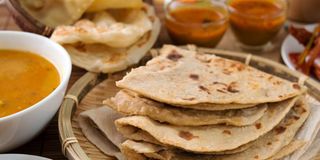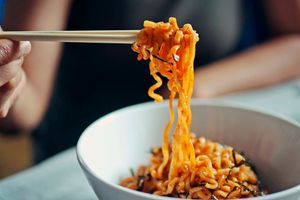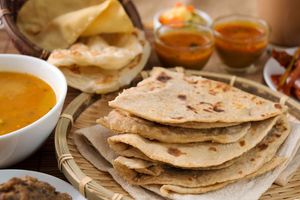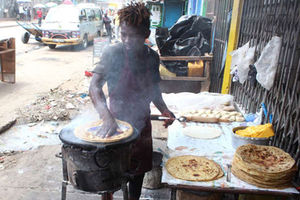
Chapatis ready for consumption.
If you can go a whole day in Kenya without seeing, smelling, or—let’s be honest—eating a chapati, you deserve a medal.
For the rest of us, this golden, flaky flatbread is less of a side dish and more of a way of life.
It’s the unofficial currency of family gatherings, the unspoken bond between friends and, according to some, the only thing standing between them and an "emotional gap."
Whether it’s plain, stuffed, rolled, or swimming in stew, chapati doesn’t just call your name, it practically shouts from the plate, daring you to say no.
But where is the line between chapati lover and chapati addict? And is it even possible to say no to that goodness?
Just ask Kalekye Willie, 48, whose lifelong bond with chapatis began at age nine.
Her first taste—chapatis soaked in stew—was so delicious, she admits she overate. From then on, chapati became her loyal companion: always filling, always satisfying, always irresistible.
“In a day, I eat about eight. Two in the morning with tea, one at 10 am two at lunch, one at 4 pm and two at supper,” she says with a grin.
For Kalekye, if they’re stuffed, the more the merrier. Her personal favourite is Chapatis with beans cooked in coconut.
And if a day passes without one, she says she feels like something is missing.
To cut down, she simply avoids going near them. But has anyone ever told her to reduce how many she eats?
“Yes. My doctor, because I am overweight. My family also tells me to watch my eating habits—but I can’t because when I don’t eat chapati, I feel an emotional gap,” she says in an interview.

Chapati is a staple meal in many homes in Kenya.
For Quinter Oloo, 18, her love for chapatis traces back to childhood. Her mother used to make them twice a week and Quinter remembers enjoying them before heading off to school.
She tasted her first chapati at just three years old.
“What makes chapatis so irresistible to me is that they go with any meal kales, beef stew, or even curry,” she says.
These days, Quinter eats chapatis almost every day sometimes up to four. She especially loves them stuffed with meat and vegetables but her all-time favourite is chapati with beef curry.
Has she ever tried to cut down?
“Oh yes, and I felt like I lost my identity. In fact, when a day passes without me having a chapati, I feel like there’s an emotional gap,” she says.
Although her bond with chapatis remains unbreakable, Quinter says her mother has often warned her about eating too many.
“She says I should stop eating chapatis so much because they will grow in my stomach,” she says, chuckling.
Her friends always tease that she should start a chapati business not just because of her obsession, but also because of her talent in making them.
Excessive chapati consumption
For Brean Mwangi, his love affair with chapatis began when he was about seven thanks to his mother, who owned a hotel. Chapatis became irresistible simply because they were always available as he grew up.
But the chapatis that truly left a mark on him were made by his big brother in 2019.
“They had some ingredients I had not tried before milk, grated carrots and green peppers. They were really yummy,” she says.
These days, Brean eats between six and eight chapatis daily.
“In the morning, I eat them with eggs. At lunch, maybe with peas or green gram stew, which is my favourite. Then for supper, with meat,.If I go a day without eating chapati, I feel so empty,” he admits.
Has he ever tried to cut down?
“I’ve been trying because of dieting and exercising, but I keep lying to my diet. I’m not able to resist them. Every time I pass a joint that makes them, I stop and buy. I actually love them hot.”
Even his gym instructor has urged him to reduce his chapati intake, especially since his pot belly persists despite his workouts.
But Brean’s obsession hasn’t gone unnoticed. “My mum is always concerned when I don’t eat chapati at functions. She’ll ask, ‘Tangu lini ukakua hukuli chapati?’ (Since when did you stop eating chapati?)”
Maryanne Wanza, a nutritionist, says chapati addiction refers to a strong dietary dependence on chapatis as a primary food item.
While it’s not a true addiction, it often stems from routine, comfort or a lack of meal variety.
“Over-dependence usually means minimising or skipping proteins, vegetables, or fruits, while consuming three to five chapatis per meal, multiple times a day with little dietary diversity,” she says.
In the short term, excessive chapati consumption can lead to blood sugar spikes—followed by energy crashes—bloating, gas, constipation, diarrhoea, or just feeling fatigued.
Long term, the risks increase. "You may experience weight gain, nutrient deficiencies from low dietary diversity, persistently high blood sugar, and elevated cholesterol levels, especially if chapatis are cooked with a lot of fat," she says.
But it's possible to enjoy chapatis in a healthy way. Ms Wanza recommends using whole wheat or multigrain flours, or even mixing in vegetable flours like sweet potato for a boost of vitamin A.
"Try adding eggs, milk, or vegetables like carrot to chapati dough for extra protein and fibre," she suggests.
When cooking, use a dry skillet or minimal oil. Limit yourself to one or two chapatis per meal, and always pair them with plenty of vegetables and lean protein for a more balanced, satisfying plate.
Brown versus white chapati: Is there a health difference?
"Absolutely—especially if you also reduce the fat used when preparing them," says Ms Wanza.
Whole wheat chapatis are higher in fibre and nutrients, which help slow glucose absorption, aid digestion, and promote satiety, making them a better choice for blood sugar control and weight management. On the other hand, white flour chapatis are lower in fibre and micronutrients, causing quicker blood sugar spikes and making them less suitable for regular consumption.
Are stuffed chapatis healthy?
Chapatis have evolved—now served as rollex, stuffed with eggs, smokies, minced meat, or paired with lettuce, avocado, and kachumbari.
"If chapatis are made with whole wheat flour and stuffed with animal or plant-based protein and plenty of vegetables, they can be part of a well-balanced, varied diet," Ms Wanza says.
But there's a catch.
"If the chapatis are large, loaded with oil or fat, and stuffed with processed meats like sausages (smokies), which are high in salt and saturated fat, then eating them frequently and in excess can raise your risk of cardiovascular disease, high blood pressure, and high cholesterol over time," she cautions.







